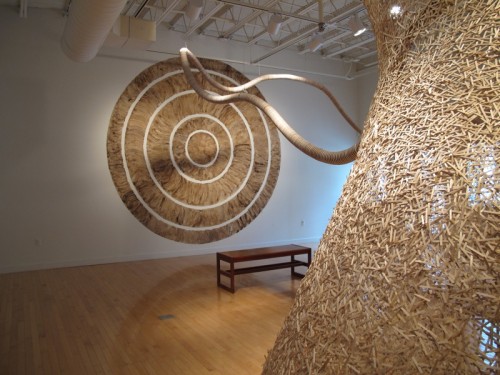ARCHIVES
Thinking about walls again
I’ve been thinking about my relationship to the walls and how they serve my interest in drawing my way through a space with my chosen palette of materials and processes. I don’t imagine myself being revolutionary, but rather I am extending my desire to learn more about how I relate to the exhibition space and ultimately a viewers experience of it. Even if in most situations I am simply considering my sense of movement and pacing through a space and choosing not to hang work walls. There was once a desire on my part to not use the wall at all. This was part of an imagined set of rulesI imposed on my systems of working. I felt an object should be created that was linked to the space but did not literally penetrate the space like many works that open up or gauge or emerge from walls. I also didn’t want the convemntional exeperience that one has with reading a painting or print hanging on a wall. However many of those in charge of spaces get anxious if walls are empty. Ultimately work hanging on a wall helps remind a veiwer that this is not an otherworldly experience but simply an art exhibition. I thought I had my solution to my imagined wall problem in the stacked and arranged lid pieces. I have been fortunate to make about one lid wall a year since 2006. Since they; A) Require an exhibition space to be installed and scaled for and b) Look best on a clean gallery wall under gallery lighting, I tend to only include them in shows that allow for enough time and space to be created. I suppose if I had been making one a month like the sticks I would have moved through several intended variations. But like the sticks I can only respond to what I dislike in the previous work in order to enhance the next work.
In this first version in 2006
- 1000 black lids and 1000 white lids arranged on the wall, 2006, redux cac
I was just simply learning what patterns and visual rythms the solo cup traveler lid would make on a wall and which pins worked best on sheetrocked walls. I also began to understand the value of scaling the work to suit the dimensions of the wall and space itself rather than any sort of scale related to my body or presence in front of the work.
In another version in 2009
- black, brown and white ,lids arranged on the wall, McMaster Gallery, 2009
I expanded the color range by securing a sample case of brown lids to add to my collection of white and black lids. This time I created a tryptich of lids that moved in color and pattern. As well the arrangment of the lid circles mimicked the arrangement of the 3 prints hanging on the opposite wall
the prints were also alternatley framed in black and white frames reinforcing the color and hanging rythm. For some reason, that I have never stopped to question, these considerations are very important to me. That any site-work be in harmony with any framed work. In this sense all of the works in an exhibition function as one continuos piece.
In 2010 when I was installing the finale of the have sticks will travel work I created another variation,
- white, brown and black lids arranged in a circle, McColl Center 2010
This time combining the white, brown and black lids into one piece. This really qualified as the most multi colored work I had made in the have sticks will travel body of work. I enjoyed the sense of play and movement that this piece made and filed that away until the next wall presented itself in 2011.
- black, brown and white lids in three alternating circles, visarts richmond, 2011
With The Richmond show the generous space allowed not only for 3 architecturally scaled circles, but also enough white space between them that if one chose to stare at any circle for more than a few minutes an after image would appear on the next one.
I’ve indulged in all this talk of walls because my next gig, starting in about 10 days, not only gives me some interesting walls and corners, but 5weeks on site versus my usual 8-10 days. Further my recently completed installation at the Flanders gallery, located a mile from the next one, will still be up through the first half of the residency. One of the things I enjoyed doing in the flanders show was planning ahead to incorporate and include the framed wall works as part of the built work.
- The flanders piece, with related print works, 2012
This was very satisfying. Rather than being merely divorced stand alone editions, these prints are seen with the materials or images that they are creating a record of on paper. The GR Haze lithograph amongst the shadows on the wall, and the gr impression in proximity to the materials that served as the printing “plate”.
Finally the other, and most satsifying solution for the wall, I plan to explore further while in residence at artspace is the coffee ground stainings. While the first version was simply a stenciled text piece in 2010, and a subsequent variation provided a colored background for unframed prints, the one created for “Weaving, Stacking and Staining, 2012″ was the closest to what I hope to do next with the walls.
- Grounds for Removal, 2012, espresso dust and water
So starting July 2nd I can dust off my coffee grounds, and gather up my lid collection as I dig in to my Artspace Raleigh, 2012 Residency project “To Weave. To Stack. To Stain.”






